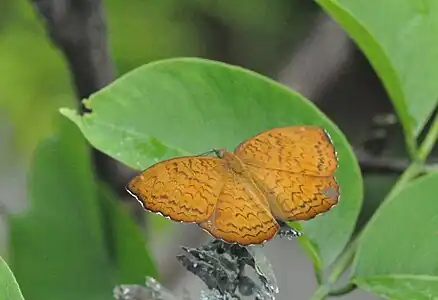Ariadne ariadne
Ariadne ariadne, the angled castor, is a species of nymphalid butterfly found in Asia.[1][2]
| Angled castor | |
|---|---|
 | |
| Scientific classification | |
| Domain: | Eukaryota |
| Kingdom: | Animalia |
| Phylum: | Arthropoda |
| Class: | Insecta |
| Order: | Lepidoptera |
| Family: | Nymphalidae |
| Genus: | Ariadne |
| Species: | A. ariadne |
| Binomial name | |
| Ariadne ariadne | |
| Synonyms | |
|
Ergolis ariadne | |
Description
This butterfly is orange brown with wavy lines running across. The margin is somewhat wavy and appearing truncated at the apex of the forewing. The margin is wavy with a large angle present on the fifth vein interspace and at the tip of vein three. The tornus is broadly angulate. The hindwing termen is deeply scalloped. There is a prominent white spot towards the apex of the forewing. The cilia are white, alternated with brown. On the underside there is more brown.
Antennae, head, thorax and abdomen ochraceous rufous. Males have a series of dark shining scales (androconia) on the subcostal vein, veins 6 and 7 and a patch on the underside of the forewing towards the base. Females look similar but are slightly paler and lacking the androconial scales.[3][4]
Ariadne ariadne bears much resemblance to Ariadne merione, the common castor, but in the angled castor, the transverse chestnut bands are narrower and less diffuse. The margins of the common castor are less wavy.
Food plants
The castor plant (Ricinus communis) is the most common host and gives the butterfly its name. Other hosts include Tragia cannabina, Tragia hispida, Tragia plukenetii and Tragia involucrata.[3][5]
Larva
The caterpillars are spiny with two rows of spines on the top. Finer spines emerge between these rows. An irregular set of small spines form a cluster at the end. The colour is variable, sometimes green with longitudinal dark brown lines, or dark brown with an interrupted broad dorsal stripe of pure white, not extending to either end.[3]
Pupa
"Slender, wing-cases somewhat dilated, a dorsal protuberance and two small cephalic points: colour variable: rigidly attached by the tail, so that if the surface is vertical, the pupa stands out horizontally." (Davidson & Aitken.)[3]
- Life cycle
_%E2%80%93_Angled_Castor_on_Tragia_plukenetii_Ds.jpg.webp) Larva (Early stage)
Larva (Early stage).jpg.webp) Larva
Larva.jpg.webp) Pupa
Pupa Imago (dorsal view)
Imago (dorsal view).jpg.webp) Imago (ventral view)
Imago (ventral view)
References
- R.K., Varshney; Smetacek, Peter (2015). A Synoptic Catalogue of the Butterflies of India. New Delhi: Butterfly Research Centre, Bhimtal & Indinov Publishing, New Delhi. p. 210. doi:10.13140/RG.2.1.3966.2164. ISBN 978-81-929826-4-9.
- Savela, Markku. "Ariadne ariadne (Linnaeus, 1763)". Lepidoptera and Some Other Life Forms. Retrieved June 30, 2018.
-
 One or more of the preceding sentences incorporates text from this source, which is in the public domain: Bingham, Charles Thomas (1907). Fauna of British India. Butterflies Vol. 2. pp. 461–462.
One or more of the preceding sentences incorporates text from this source, which is in the public domain: Bingham, Charles Thomas (1907). Fauna of British India. Butterflies Vol. 2. pp. 461–462. -
 One or more of the preceding sentences incorporates text from this source, which is in the public domain: Moore, Frederic (1901–1903). Lepidoptera Indica. Vol. V. London: Lovell Reeve and Co. pp. 17–20.
One or more of the preceding sentences incorporates text from this source, which is in the public domain: Moore, Frederic (1901–1903). Lepidoptera Indica. Vol. V. London: Lovell Reeve and Co. pp. 17–20. - Ravikanthachari Nitin; V.C. Balakrishnan; Paresh V. Churi; S. Kalesh; Satya Prakash; Krushnamegh Kunte (2018-04-10). "Larval host plants of the buterfies of the Western Ghats, India". Journal of Threatened Taxa. 10 (4): 11495–11550. doi:10.11609/jott.3104.10.4.11495-11550 – via JoTT.